#The Palace of Charles V
Text
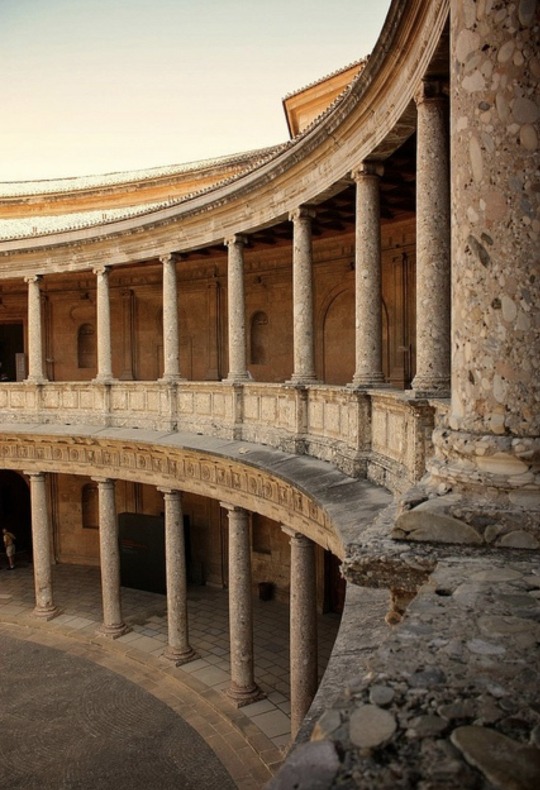
60 notes
·
View notes
Text
At least four previous generations of British monarchs have greeted the public from the balcony of Buckingham Palace following their Coronation at Westminster Abbey.

King George V, 1911

King George VI, 1937

Queen Elizabeth II, 1953

King Charles III, 2023
#Coronation 1911#Coronation#Coronation 1937#Coronation 1953#Buckingham Palace#Westminster Abbey#King George V#King George VI#Queen Elizabeth II#King Charles III#British Royal Family
62 notes
·
View notes
Text
TAG DROP NO. 2 !
#💀 » 020 / CHARLES ROWLAND.#💀 » 021 / EDWIN PAINE.#💀 » 022 / CRYSTAL PALACE.#💀 » V. 001 / BRAWN.#💀 » V. 002 / LIVING.
0 notes
Note
Hi!! Thank you for writing in such detailed way abt what’s happening in France. You’re my fave blog to read when I need to decompress and seeing you write abt the situation from perspective of a French person and not a USA/British journalist was v illuminating! Thank you again
Thank you <3 I feel bad because a lot of people have told me in the past that they find my blog soothing but I've been feeling such despair lately at the state of my country. And I feel a bit helpless here where there's not much I can do besides sharing information. I went to a quiet, civilised small town protest yesterday but I found a llama sitter for next week so I'll be able to go to Paris for Tuesday's protest so it's not always the same people getting gassed ^^'. Learning this morning that Charles III's visit was cancelled was great—I'm kind of sad that we won't get to see pictures of angry crowds waving pitchforks and cardboard guillotines but Macron really badly wanted this stupid dinner in Versailles and we're enjoying his humiliation. Also just this morning the Minister of the Interior was announcing, "France is ready for Charles III's visit", head firmly buried in the sand, and two hours later it was "Charles III's visit cancelled; France is too chaotic right now." Ha.
(I don't know if this is known across the pond but the Mobilier National (employees of the Culture Ministry who provide the furniture for this kind of official visit) announced they were going on strike earlier this week so they wouldn't be providing anything for Charles' visit, out of solidarity with striking British workers. We had fun picturing Macron and Charles III having a banquet at the Palace of Versailles on Ikea chairs)
675 notes
·
View notes
Text

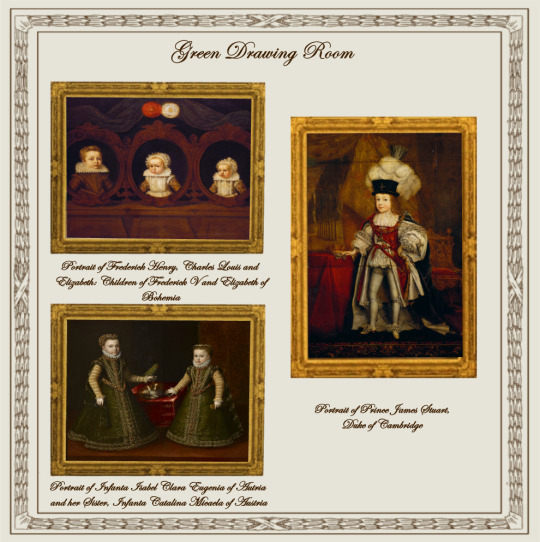
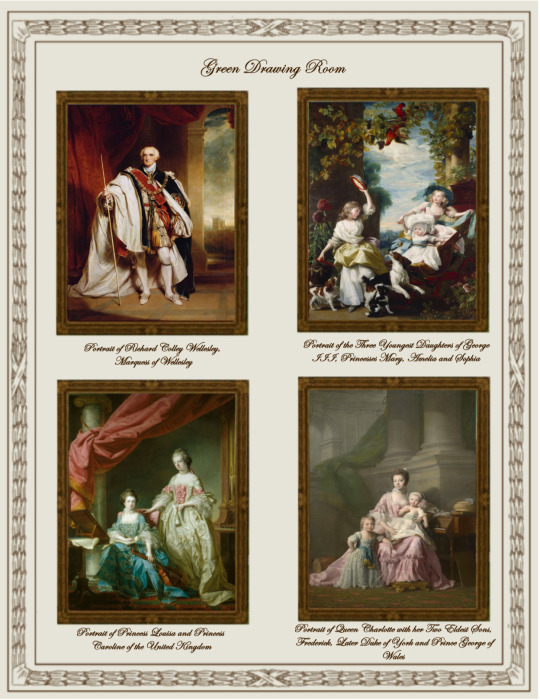
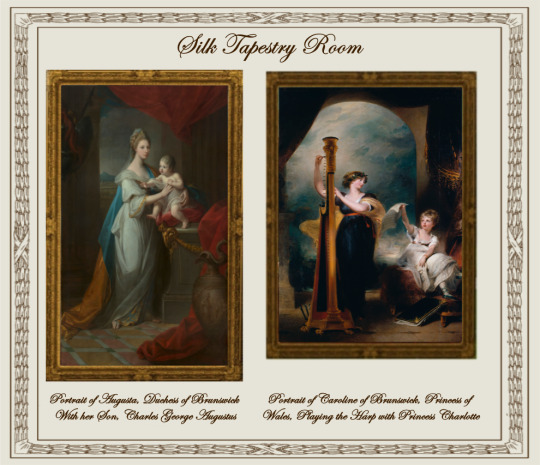
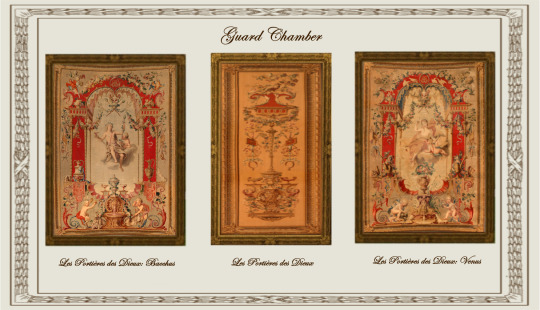

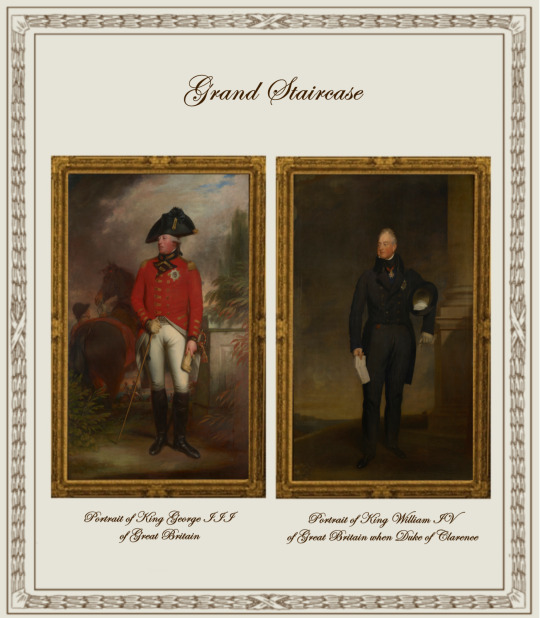
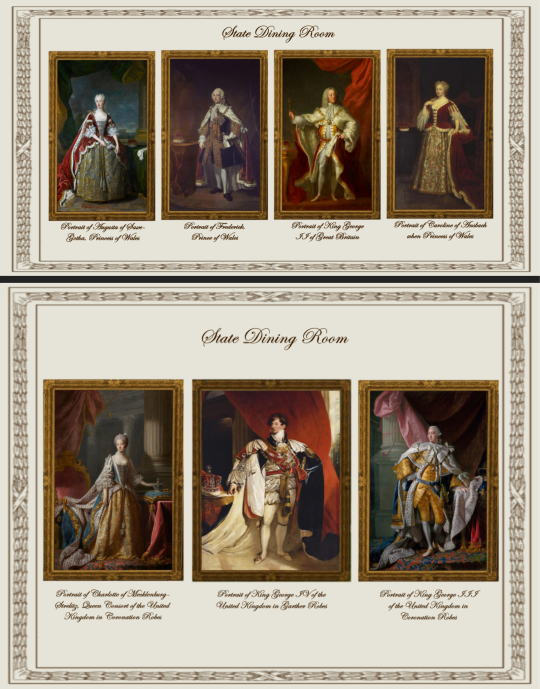
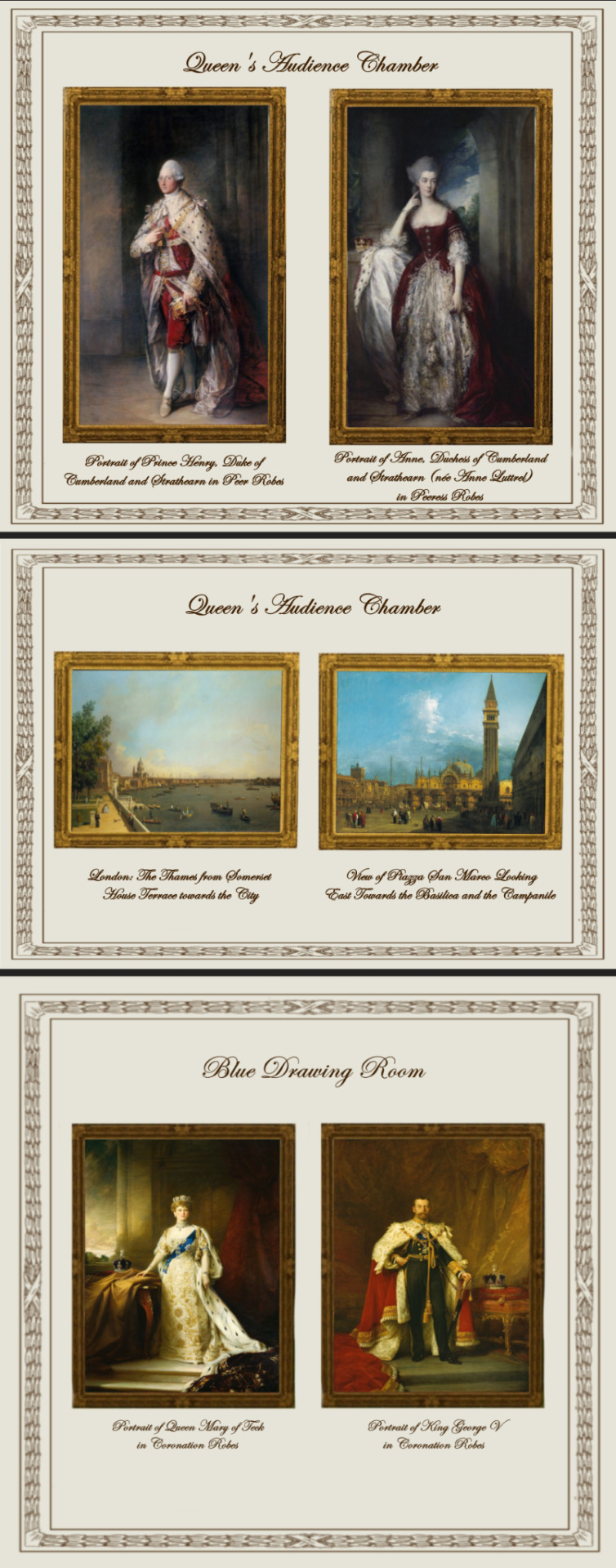
Paintings from Buckingham Palace: part I
A retexture by La Comtesse Zouboff — Original Mesh by @thejim07
100 followers gift!
First of all, I would like to thank you all for this amazing year! It's been a pleasure meeting you all and I'm beyond thankful for your support.
Spread among 13 occupied and historic royal residences in the United Kingdom, the collection is owned by King Charles III and overseen by the Royal Collection Trust. The British monarch owns some of the collection in right of the Crown and some as a private individual. It is made up of over one million objects, including 7,000 paintings, over 150,000 works on paper, this including 30,000 watercolours and drawings, and about 450,000 photographs, as well as around 700,000 works of art, including tapestries, furniture, ceramics, textiles, carriages, weapons, armour, jewellery, clocks, musical instruments, tableware, plants, manuscripts, books, and sculptures.
Some of the buildings which house the collection, such as Hampton Court Palace, are open to the public and not lived in by the Royal Family, whilst others, such as Windsor Castle, Kensington Palace and the most remarkable of them, Buckingham Palace are both residences and open to the public.
About 3,000 objects are on loan to museums throughout the world, and many others are lent on a temporary basis to exhibitions.
-------------------------------------------------------
This first part includes the paintings displayed in the White Drawing Room, the Green Drawing Room, the Silk Tapestry Room, the Guard Chamber, the Grand Staircase, the State Dining Room, the Queen's Audience Room and the Blue Drawing Room,
This set contains 37 paintings and tapestries with the original frame swatches, fully recolourable. They are:
White Drawing Room (WDR):
Portrait of François Salignan de la Mothe-Fénelon, Archbishop of Cambrai (Joseph Vivien)
Portrait of a Lady (Sir Peter Lely)
Portrait of a Man in Armour with a red scarf (Anthony van Dyck)
Portrait of Alexandra of Denmark, Queen Consort of the United Kingdom and Empress of India (François Flameng)
Green Drawing Room (GDR):
Portrait of Prince James Stuart, Duke of Cambridge (John Michael Wright)
Portrait of Frederick Henry, Charles Louis and Elizabeth: Children of Frederick V and Elizabeth of Bohemia (unknown)
Portrait of Infanta Isabel Clara Eugenia of Autria and her Sister, Infanta Catalina Micaela of Austria (Alonso Sanchez Coello)
Portrait of Princess Louisa and Princess Caroline of the United Kingdom (Francis Cotes)
Portrait of Queen Charlotte with her Two Eldest Sons, Frederick, Later Duke of York and Prince George of Wales (Allan Ramsay)
Portrait of Richard Colley Wellesley, Marquess of Wellesley (Martin Archer Shee)
Portrait of the Three Youngest Daughters of George III, Princesses Mary, Amelia and Sophia (John Singleton Copley)
Silk Tapestry Room (STR):
Portrait of Caroline of Brunswick, Princess of Wales, Playing the Harp with Princess Charlotte (Sir Thomas Lawrence)
Portrait of Augusta, Duchess of Brunswick With her Son, Charles George Augustus (Angelica Kauffmann)
Guard Chamber (GC):
Les Portières des Dieux: Bacchus (Manufacture Royale des Gobelins)
Les Portières des Dieux: Venus (Manufacture Royale des Gobelins)
Les Portières des Dieux (Manufacture Royale des Gobelins)
Grand Staircarse (GS):
Portrait of Adelaide of Saxe-Meiningen, Queen Consort of Great Britain (Martin Archer Shee)
Portrait of Augustus, Duke of Sussex (Sir David Wilkie)
Portrait of Edward, Duke of Kent (George Dawe)
Portrait of King George III of Great Britain (Sir William Beechey)
Portrait of King William IV of Great Britain when Duke of Clarence (Sir Thomas Lawrence)
Portrait of Leopold I, King of the Belgians (William Corden the Younger)
Portrait of Prince George of Cumberland, Later King George V of Hanover When a Boy (Sir Thomas Lawrence)
Portrait of Princess Charlotte Augusta of Wales (George Dawe)
Portrait of Queen Charlotte at Frogmore House (Sir William Beechey)
Portrait of Victoria of Saxe-Coburg-Saafeld, Duchess of Kent (Sir George Hayter)
State Dining Room (SDR):
Portrait of Charlotte of Mecklenburg-Strelitz, Queen Consort of the United Kingdom in Coronation Robes (Allan Ramsay)
Portrait of King George III of the United Kingdom in Coronation Robes (Allan Ramsay)
Portrait of Augusta of Saxe-Gotha, Princess of Wales (Jean-Baptiste Van Loo)
Portrait of Caroline of Ansbach when Princess of Wales (Sir Godfrey Kneller)
Portrait of Frederick, Princes of Wales (Jean-Baptiste Van Loo)
Portrait of King George II of Great Britain (John Shackleton)
Portrait of King George IV of the United Kingdom in Garther Robes (Sir Thomas Lawrence)
Queen's Audience Room (QAR):
Portrait of Anne, Duchess of Cumberland and Strathearn (née Anne Luttrel) in Peeress Robes (Sir Thomas Gainsborough)
Portrait of Prince Henry, Duke of Cumberland and Strathearn in Peer Robes (Sir Thomas Gainsborough)
London: The Thames from Somerset House Terrace towards the City (Giovanni Antonio Canal "Canaletto")
View of Piazza San Marco Looking East Towards the Basilica and the Campanile (Giovanni Antonio Canal "Canaletto")
Blue Drawing Room (BDR)
Portrait of King George V in Coronation Robes (Sir Samuel Luke Fildes)
Portrait of Queen Mary of Teck in Coronation Robes (Sir William Samuel Henry Llewellyn)
-------------------------------------------------------
Found under decor > paintings for:
500§ (WDR: 1,2 & 3)
1850§ (GDR: 1)
1960§ (GDR: 2 & 3 |QAR 3 & 4)
3040§ (STR, 1 |GC: 1 & 2|SDR: 1 & 2)
3050§ (GC:1 |GS: all 10|WDR: 4 |SDR: 3,4,5 & 6)
3560§ (QAR: 1 & 2|STR: 2)
3900§ (SDR: 7| BDR: 1 & 2|GDR: 4,5,6 & 7)
Retextured from:
"Saint Mary Magdalene" (WDR: 1,2 & 3) found here .
"The virgin of the Rosary" (GDR: 1) found here .
"The Four Cardinal Virtues" (GDR: 2&3|QAR 3 & 4) found here.
"Mariana of Austria in Prayer" (STR, 1, GC: 1 & 2|SDR: 1 & 2) found here.
"Portrait of Philip IV with a lion at his feet" (GC:1 |GS: all 10|WDR: 4 |SDR: 3,4,5 & 6) found here
"Length Portrait of Mrs.D" (QAR: 1 & 2|STR: 2) found here
"Portrait of Maria Theresa of Austria and her Son, le Grand Dauphin" (SDR: 7| BDR: 1 & 2|GDR: 4,5,6 & 7) found here
(you can just search for "Buckingham Palace" using the catalog search mod to find the entire set much easier!)
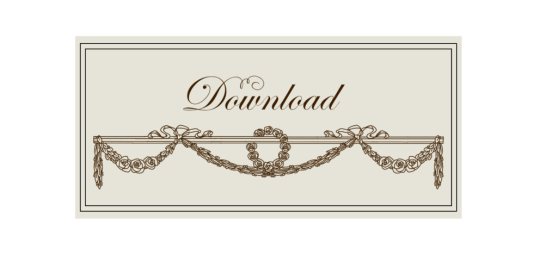
Drive
(Sims3pack | Package)
(Useful tags below)
@joojconverts @ts3history @ts3historicalccfinds @deniisu-sims @katsujiiccfinds @gifappels-stuff
-------------------------------------------------------
#the sims 3#ts3#s3cc#sims 3#sims 3 cc#sims 3 download#sims 3 decor#edwardian#rococo#baroque#renaissance#buckingham#buckingham palace#royal collection trust#wall decor
95 notes
·
View notes
Note
hi mal, hope ur having a great day!!
little mermaid au pls ❤️
also sorry about this, i rmbr you posting something about a bi charles au and a mechanic au last year and i was just wondering if ur planning to still write them 👀 absolutely no pressure though, im sorry if it comes off that way
have a great rest of your day 💛
Hi! I hopefully will pick up those two wips again, but I've already shared as much as I can of those and haven't added anything since last time 😭 so I couldn't include them this time...
BUT I can share a little more of the little mermaid one for sure ❤️
Charles pulls uncomfortably at the collar of his shirt, eventually just unfastening some of the ties so it hangs loose across his chest. He isn’t used to being clothed, therefore everything feels tight and abrasive against his skin.
He’d almost immediately tugged off the boots he’d been given once he was alone, much preferring to accustom himself to walking barefoot and feeling the ground against the pads of his feet. What was the point of finally having feet to run and jump and dance if he imprisoned them in those leather cages they called shoes?
He’d been cleaned and clothed and checked over by a doctor, all of which had been a rather intrusive experience. He’d been scrubbed and brushed and prodded and maneuvered about, then deemed healthy enough, although there was some mild concern over his difficulty walking and lack of voice. But the doctor had seemed to attribute the walking problem to sore legs from swimming ashore, as he must’ve done to survive the shipwreck, and his missing voice to shock, which he believed would return in time.
Charles had then been shown to his quarters, which constituted a lovely, large bed and a window overlooking the sea, until such a time that they could determine who he was, exactly. Charles had almost immediately collapsed into the bed, something he’d dreamed of after discovering humans slept in nests of soft, cushy feathers, and fallen into a deep, dreamless sleep. When he awoke, he had a growling belly and a thousand questions.
What all had happened in that witch’s cave? What had he agreed to? What was it he gave in exchange for legs? Just his voice? Or something else, as well? How long would he be like this? Forever? Or was he on borrowed time?
He’d decided to deal with the hunger first. And somehow, he’d found what he believed was the palace’s place for preparing food. Which brings him to now, standing in the doorway as he watches people dressed in all white, running about, food strewn across surfaces, all kinds of utensils in their hands as they slice and stir and taste.
He feels frozen to the spot, unsure if he’s supposed to be here, but unable to ask anyone where else he can find something to eat. And no one has looked his way, all of them absorbed in their tasks.
Charles is about to venture inside, when he hears a strange sort of roar-like shout, repeated over and over and getting closer. Then, he spots a hairy four-legged creature running toward him at full speed. Charles thinks he’s under attack (he would probably scream if he were able) so that when the creature jumps toward him, Charles trips backward, protecting his face as he’s clawed at.
But after a moment of expecting pain only to be met with a wet, slobbery tongue licking repeatedly over his hands and face, he realizes maybe he’s not under attack. He peeks out from behind his hands to look at the beast, whose hot breath puffs against his chin, and suddenly recognizes it as the creature the man on the ship had nearly died staying to save - the creature Charles had helped onto the boat.
The beast barks again, and Charles startles, but he doesn’t get clawed at or bitten. So he reaches out a tentative hand and scratches behind its ear. The beast leans heavily into the contact with a look of utter satisfaction on its face.
Charles smiles, warmth filling him up with the urge to laugh. He gets a lick to the face that almost knocks him onto his back.
“Piñon!” a voice calls out, and Charles looks up to see a man come around the corner.
Not just a man - him.
WIP Wednesday
21 notes
·
View notes
Text


─ •✧ WILLIAM'S YEAR IN REVIEW : APRIL ✧• ─
1 APRIL - William and King Charles planted a tree marking the end of Queen's Green Canopy.
8 APRIL - William and George attended the Premier League Aston Villa V Nottingham Forest match at Villa Park.
9 APRIL - William, Catherine and their three kids attended the Easter Mattins Service at St. George's Chapel.
20 APRIL - William and Catherine were received by Sir David Thompson (Deputy Lieutenant of West Midlands).at the Indian Streatery in Birmingham. Afterwards, Mr. Lawrence Barton (Deputy Lieutenant of West Midlands) received them as they gave a Reception at the Rectory. William also appeared in a video supporting the #NoButts Campaign.
24 APRIL - William received Mr. Alastair Martin (Secretary of the Duchy of Cornwall).
25 APRIL - William was received by Colonel Jane Davis (Vice Lord-Lieutenant of Greater London) as he attended the Anzac Day Dawn Service and laid a wreath at Wellington Arch.
26 APRIL - He was represented by Lieutenant Commander James Benbow RN at the Funeral of Mr. Bryn Parry (Co-Founder, Help for Heroes).
27 APRIL - William and Catherine were received by Mr. Peter Vaughan (His Majesty's Lord-Lieutenant of Mid Glamorgan) as they attended a training session with Central Beacons Mountain Rescue Team to mark their Sixtieth Anniversary. They later, picked up dinner foreveryone from the Little Dragon Pizza Van as they visited Dowlais Rugby Club.
28 APRIL - William and Catherine were received by His Majesty's Lord-Lieutenant of Mid Glamorgan (Mr. Peter Vaughan) at the Aberfan Cemetery and afterwards. Later, they visited the Aberfan Disaster Memorial Garden and met local people who were involved in the disaster.
29 APRIL - Kensington Palace released a new portrait featuring Catherine and William to mark their 12th Wedding Anniversary.
#review april#review 2023#year in review : william#william review : april#year in review 2023 : william#year in review : 2023#british royal family#british royals#royalty#royals#brf#royal#british royalty#prince of wales#the prince of wales#prince william#royaltyedit#royalty edit#my edit#my photoset#princess of wales#the princess of wales#princess catherine#kate middleton#catherine middleton#duchess of cambridge#princess kate#royal family#duke of cambridge#prince and princess of wales
51 notes
·
View notes
Text




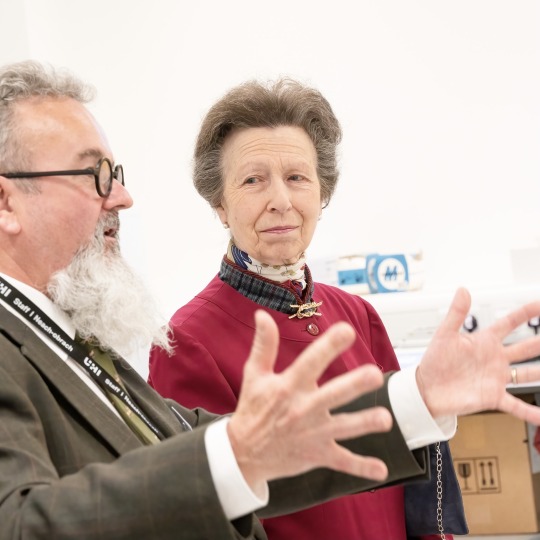
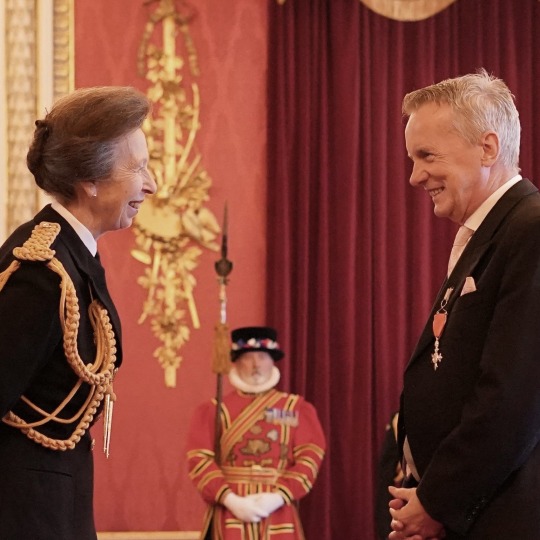
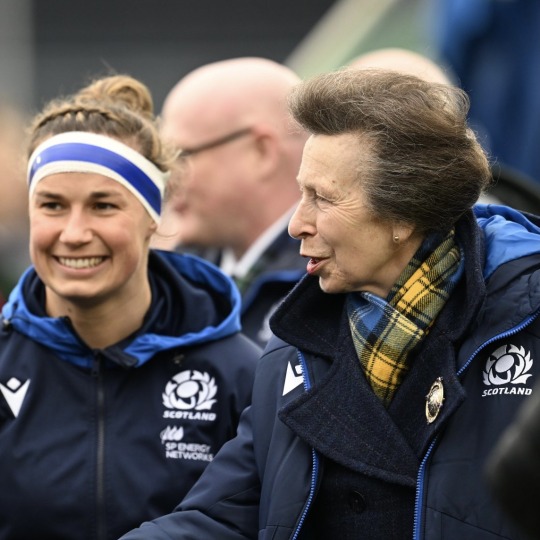


The Princess Royal’s Official Engagements in April 2023
03/04 In Glamorgan, Wales Princess Anne carried out the following engagements;
As Patron of the Royal College of Midwives, visited Prince Charles Hospital, Merthyr Tydfil. 👶
As President of Carers Trust, visited Bridgend Carers Centre, Bridgend. 🩼
As Royal Patron of the National Coastwatch Institution, opened St Donat’s Bay Station, United World Colleges Atlantic College, St Donat’s, followed by a Reception at St Donat’s Castle, Llantwit Manor. 🚤
04/04 In Worcestershire and Gloucestershire, Princess Anne carried out the following engagements;
As Patron of the Worcestershire and Sherwood Foresters Regimental Association, HRH dedicated the Norton Worcestershire Regiment Group, in Norton. 🌲
As President of Carers Trust, HRH visited Crossroads Care Gloucestershire, at Daglingworth Village Hall, Daglingworth. 🩺
Opened Eastwood Park Limited’s Training Centre, Falfield, Wotton-Under-Edge. 👩🎓
Visited Wickwar Town Hall, Wickwar, Wotton-Under-Edge 🏫
09/04 unofficial Princess Anne and her husband, Sir Tim Laurence, attended the Easter Sunday Mattins Service at St. George’s Chapel in Windsor. Also in attendance were King Charles, Queen Camilla, the Prince and Princess of Wales, Prince George, Princess Charlotte, Prince Louis, the Duke and Duchess of Edinburgh, James, Earl of Wessex, Peter Phillips, Zara, Mike, Mia and Lena Tindall, Princess Beatrice, Edoardo Mapelli-Mozzi, Princess Eugenie, Jack Brooksbank, Lady Sarah Chatto and Daniel Chatto. 🐣
~~🐣 Easter break 🐣~~
17/04 Princess Anne carried out the following engagements in Kelso, Scotland;
Visited Kelso Racecourse for their Bicentenary Race Day and met Grand National ‘23 winner Corach Rambler.
Afterwards HRH attended a Reception for Carers at the Racecourse. 🥂
18/04 Princess Anne carried out the following engagements in the Scottish Highlands;
Opened the Life Sciences Innovation Centre at the University of the Highlands and Islands, Inverness Campus. 🧑🎓
Visited the Lochaber Rural Education Trust in Torlundy, Fort William.✏️
Opened the new Corpach Marina, Caledonian Canal, Corpach in Fort William. 🚤
19/04 As Patron of the Spinal Injuries Association, Princess Anne attended a Reception at Hoare Memorial Hall in Westminster, London. 🩼
Later as President of the Royal Society for the encouragement of Arts, Manufactures and Commerce, accompanied by Sir Tim, HRH attended the President’s Lecture and Dinner. 👨🏫
20/04 The Princess Royal, held an Investiture ceremony at Buckingham Palace. 🎖️
As Patron of the Royal College of Emergency Medicine, attended the Spring Conference. 💊
21/04 Attended HMS Raleigh’s Phase One Training Passing Out Parade in Cornwall 🫡
22/04 Princess Anne and Sir Tim attended the Women’s Six Nations Scotland v Ireland games in Edinburgh 🏴🇮🇹🏉
25/04 Princess Anne carried out the following engagements in Northern Ireland;
As Patron of Save the Children UK, visited their charity shop in Ballycastle as they were celebrating celebrating their 10th birthday of opening. 🎂
As Patron of the National Museum of The Royal Navy, opened HMS Caroline museum, after restoration of HMS Caroline and the Pumphouse in Alexandra Dock, Belfast. ⛴️
26/04 Princess Anne as Patron of the Whitley Fund for Nature, accompanied by Sir Tim, attended the Whitley Awards Ceremony at the Royal Geographical Society, Kensington. 🦋🌳
27/04 Princess Anne carried out several engagements in London;
As Patron of Livability, attended a ‘Changes for the Future’ Forum. 🏘️
As Admiral of the Sea Cadet Corps, HRH opened the brand new National Support Centre and attended a Sea Cadet Forum. 🌊
The Princess Royal, As Patron of the Learning and Work Institute, attended an ‘Art for the People’ Forum. 🖼️
As President of The Duke of Edinburgh’s Commonwealth Study Conferences, held a Dinner at St. James’s Palace for the Commonwealth Study Conferences Canada’s President’s Council and the Study Conference 2023. 🍽️
28/04 unofficial As the brand new President of the Gloucestershire Warwickshire Railway Trust Sir Tim visited one of the stations and met various volunteers of the railway, had a look around the Signalbox and Carriage & Wagon at Winchcombe in Gloucestershire. 🚂
Total official engagements for Anne in April: 29
2023 total so far: 171
Total official engagements accompanied by Tim in April: 3
2023 total so far: 41
#unofficial means it wasn’t in the court circular so it hasn’t been added to the total#hardest working royal 🫡#no choice but to stanne#this is based of the court circular#monthly engagement post#april 2023#and yes i’m doing a seperate count for tim too#because i’m rooting for…#operation working royal tim#charles i hope you’re listenanne#not all engagements are listed on this post#if you want a full list plz dm me 💕#princess anne#princess royal#tim laurence#timothy laurence#brf
59 notes
·
View notes
Text
Meghan cited a "convention" that the grandchildren of the monarch are titled prince or princess. Under protocol set up by King George V in 1917, the children and grandchildren of a sovereign have the automatic right to the title HRH, or His or Her Royal Highness, and the title of prince or princess. That extension does not apply to the great-grandchildren of a monarch, although Queen Elizabeth made an exception giving the titles to William's children because they are directly in the line of succession.
When Archie was born, Harry and Meghan announced his name as Archie Mountbatten-Windsor, the surname used by the royal family. But, as Meghan pointed out in the interview, Archie and the baby girl they're expecting this summer would be entitled to become prince and princess when Harry's father, Prince Charles, becomes king.
"Even with that convention I'm talking about — while I was pregnant, they said they wanted to change the convention for Archie. Well why?" Meghan said. She said she was never given an answer.
~ CBS News, Meghan says Archie's title was not royal family's "right to take away," 09 March 2021
Discussing the move on the latest episode of the Palace Confidential series, the Mail on Sunday's Assistant Editor Kate Mansey said the newly-appointed Duke and Duchess of Edinburgh were surprised to learn that James would not inherit his father's new title.
She explained: 'My sources say that they had assumed that they would get the Duke and Duchess title and it would go to James. Because why would you get a Dukedom and it not pass to your son?'
However, Kate said this is an example of King Charles 'looking ahead' to the future of his 'slimmed down' monarchy.
She continued: 'As James gets older has his children, they have children, you're [left with] a Duke of Edinburgh title that is so far removed from the Crown.
'And it's a really important title. You can't have a situation where the Duke of Edinburgh is in several generations' time so far removed so as not to be considered royal.'
~ Kate Mansey, as quoted by Lydia Hawken, "Prince Edward and Duchess of Edinburgh 'always assumed' his new title would be passed down to their son James - but King Charles is 'looking ahead' to future of his 'slimmed down monarchy', Kate Mansey tells PALACE CONFIDENTIAL"
The Duke of Edinburgh’s comments at the garden party for the Duke of Edinburgh’s award, where he mentioned that everyone changing their title in a single year can get complicated, is now taking on a rather sinister tone in my mind.
~ @helenaaurellia, 10 June 2023
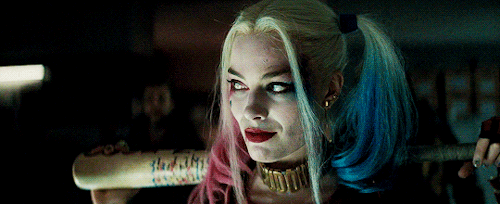
#quotes#King Charles III#Chuckie Trips FTW#King Charles III in CHARGE!#british royal family#titles 'n shit#fleet street#Daily Mail#Kate Mansey#Lydia Hawken#2024: Year of the Wood Dragon#prince harry#the disgusting one doesn't get his name in a tag#princess beatrice#princess eugenie#archie mountbatten windsor#lilibet diana mountbatten windsor#A stupid name for a stupid fandom™#Wales fandom ARMAGEDDON#oprah & harry & meghan and the disastrous interview#letters patent#House of Mountbatten Windsor
10 notes
·
View notes
Text
Must we, really? I’m afraid there is no avoiding the great crown soap opera as this finely crafted Prince Harry publicity spectacular engulfs the news. However nugatory the revelations about scenes of brotherly rivalry, beards, bridesmaids and broken dog bowls, it’s no use pretending it’s not happening or that the country and its households aren’t dividing into Harryites and Williamists.
Pollsters see a leave v remain rift – with leavers on the side of the monarchy and remainers inclined towards Meghan and Harry. While older people back the palace and the young lean more to Montecito, I doubt that last night’s angry and contrary ITV interview will restore Harry’s sliding ratings.
The interview landed as the next neatly choreographed step in the ace publicity machine of Prince Harry’s publishers. After the Oprah interview in 2021, six episodes of the Netflix series, teasers for his four TV interviews this week and the early leaking of his book, was there really anything new for him to say or for us to think? Nothing, beyond the painfully raw spectacle of his inchoate rage.
The palace, with its hordes of PR specialists, spent weeks war-gaming its response – it was prepared for devastating revelations, ready to break its silence if absolutely necessary. So far, its worst fears have “not come to light”, which tantalisingly suggests it thought Harry had more lethal missiles to unleash.
Of course, Harry’s words evoke some sympathy for an angry, damaged man. In what family is it psychologically acceptable to consign the younger son to service the elder for life? Few parental divorces are as horrible as the one these boys suffered, their schoolfriends snickering over the tampon tape and the James Gilbey recordings, everyone ogling Diana and Charles’s self-justifying TV interviews and books, capped by their mother’s horrific death. The monarchy teetered as the Queen misjudged the Diana moment, but then she held it together. If it could survive all that, the blow of a minor twig breaking from “the Firm” to seek his Californian revenge is hardly fatal – as he voices full support for the monarchy itself, condemning only its toxic relationship with certain portions of the press.
His one act of heroism is this dangerous duel with the tabloids that he blames for his mother’s death, as he pursues cases against the publisher of the Daily Mail, Associated Newspapers and the owners of the Daily Mirror and the Sun, the Reach plc subsidiary MGN Ltd and Rupert Murdoch’s News Group Newspapers, accusing them of phone-hacking or other breaches of privacy. His father warned that it was a suicide mission, but Harry says the royals have, in feeding the beast, made a pact with the devil. He rages at their failure to stand up to them: there was not a word from the palace in rebuke for Jeremy Clarkson’s disgusting hate attack on Meghan.
Everyone knows Harry is entirely right about the filthy, hypocritical, moralising amoral press and its corrosive effect on national life. Yet in his mist of confusion and contradictions, he doesn’t see that publicity is the monarchy’s lifeblood. When Queen Victoria withdrew from the public eye for years, her popularity plummeted. That oxygen is how the royals make their pointless living as fantasy creatures: they need the press to justify their very existence, like any celebrities. Their only role is to entertain us, and Harry plays his part perfectly. Walter Bagehot was wrong: the royals were never the “dignified” part of the constitution, but undignified performers who reduce us to infantilism in following their small dramas. Bagehot wrote that the purpose of the monarchy is “to excite and preserve the reverence of the population”. Indeed, citizens are reduced to subjects in revering this family of nothingness. Nor was Bagehot right to claim the monarchy’s “mystery is its life” and “we must not let in daylight upon magic”. The public needs feeding constantly with each new royal episode.
Of course the press is retaliating with a sewage outflow of bile, the full firing squad of rightwing commentators hating the Sussexes’ “wokery”. It stays unspoken that “wokeness” means #MeToo and Black Lives Matter, race swirling around in their loathing of “victim culture”. Harry sounds ill-equipped intellectually to take them on, unfocused in his fury against them, unpolitical, tin-eared and clueless about how his Afghanistan kill-count angered other soldiers, giving fresh ammunition to the enemy press. Don’t expect him to examine the slavery sources of some royal riches: the future William IV made a pro-slavery speech in the Lords accusing William Wilberforce’s abolition campaign of misrepresenting the treatment of enslaved people in the British sugar colonies, whose good living conditions he could attest to himself.
With the battle to re-examine the legacy of empire and slavery barely begun, the royal family’s failure to prevent Meghan’s flight is a disaster for them. Whatever restraint it took, it needed to embrace her. The Queen is gone. Charles’s pitiful King Lear plea, “Please, boys, don’t make my final years a misery”, reminds us that he lacks her reinforced steel. The monarchy’s popularity has declined for years: more 18- to 24-year-olds would now prefer to have an elected head of state, while only 53% of 25- to 49-year-olds are in its favour. As Graham Smith of Republic says, three white men in a row as kings stretching ahead for maybe the next 100 years looks singularly out of step with modern Britain.
Look at the Clarksonesque roll-call of Harry and Meghan haters and you might instinctively take Harry’s side, but no, let’s not be dragged into the psychodrama of this spin-off from The Crown. This country is braced for the deepest recession in the G7, so badly misgoverned that people can’t call an ambulance to a heart attack or police to a burglary, catch a train or stretch their shrinking wages to pay for food and heat, while public services are drained dry by austerity. Yet how easily we succumb to the great distraction of another instalment of the royal charivari, briefly diverting public anxiety and conveniently relieving pressure on the government.
Monarchy is a cast of mind that blocks reform, an unholy religion made of these remarkably unremarkable people. Despite the best education for generations, their most useful genetic function is to demonstrate that talent and intelligence is randomly assigned. Monarchy breeds in Britain a feudalism of the imagination that gives a stamp of approval to inheritance and to the inequality, risen rampantly in recent decades, that is at the root of our social and political malaise. Harry exhibits the epic unreality the royals inhabit when he imagines this: “I genuinely believe, and I hope, that reconciliation between my family and us will have a ripple effect across the entire world.” The rest of the world, I fear, enjoys the show, but laughs at our absurdity.
121 notes
·
View notes
Text
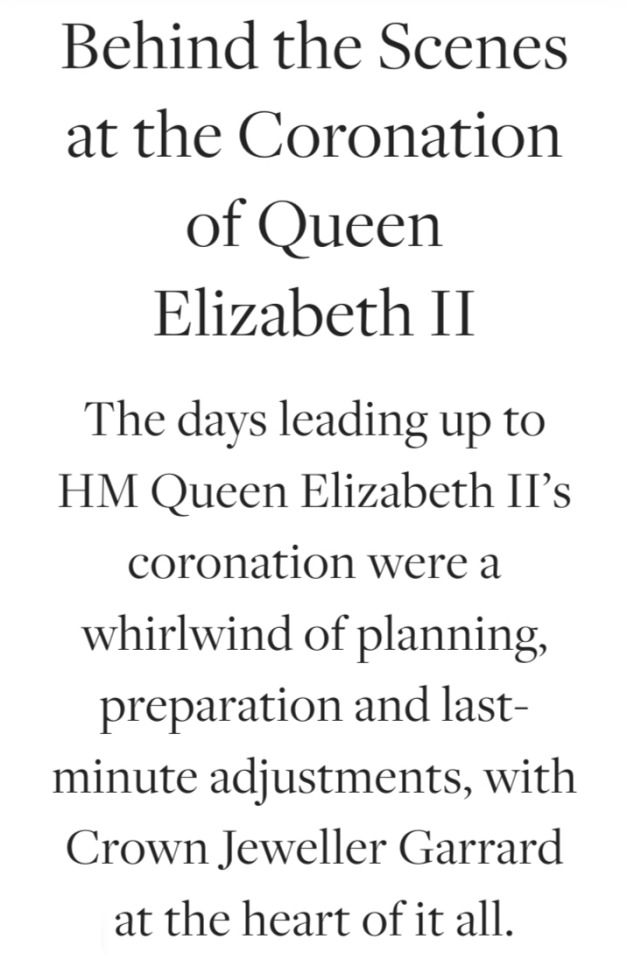

In London during the late spring of 1953, preparations for Her Majesty Queen Elizabeth II’s Coronation were reaching their denouement.
Couturier Norman Hartnell was completing a dress to outshine any other.
Tucked away at the back of Hartnell’s lavish Mayfair townhouse, a team of embroiderers were finishing stitching a floral garland on the ivory silk bodice and crinoline.
Pastel thread, jewels, sequins, beads and 10,000 seed pearls were sewn as Commonwealth emblems and British flora around an English Tudor rose scattered with diamond dewdrops.
Six young, aristocratic maids of honour, including 19-year-old Lady Anne Coke – best-selling author Anne Glenconner – were being drilled like guardsmen by The Duke of Norfolk, responsible for organising the coronation, as they rehearsed the walk to the Abbey altar, with his wife, the Duchess, standing in for The Queen.
“If the Bishops don’t learn to walk in step,” he remonstrated, “we’ll be here all night.”

The photographer Cecil Beaton, well-versed in photographing crowned heads and aristocrats in the Vogue studios, was prepping a vantage point in Westminster Abbey, high up by the organ pipes, as the best location from which to capture the ceremony.
It would be a long day; he’d fill his top hat with sandwiches to sustain him.
Nearby, at Garrard, the Crown Jeweller and his team of master craftsmen were hunched over workbenches altering the Imperial State Crown to fit the young Queen’s head.
Garrard had made the Crown in 1937 for King George VI – a replica of the crown designed and crafted for Queen Victoria, which contained virtually all the same stones symbolic of centuries of Royal history, fitted around a purple velvet cap and ermine band.

Clusters of diamond-set crosses and fleurs-de-lis linked by swags of diamonds, supported by sapphires, emeralds and pearls in the form of oak leaves and acorns, dazzled around the massive 317.40 carat Cullinan II diamond, the Second Star of Africa, cut from the largest diamond ever discovered.
Above it sat the Black Prince’s Ruby – in fact, a spinel, worn by Henry V at Agincourt – while the 104 carat oval Stuart sapphire gleamed at the rear of the band, with the cross atop the orb set with the sapphire from Edward the Confessor’s ring.
King George VI requested Garrard create an inner “hammock” style fitting, like a guard’s officer’s bearskin, to distribute the nearly three pounds of weight evenly on his head.
Reshaping the circlet for Queen Elizabeth II involved remounting the stones and motifs of which it is composed, as well as repositioning and lowering the arches, all of which required craftsmanship of the highest skill.
The aim was to improve the strength of the crown with lightness of weight, which isn’t easy with large stones, and those which were cut nearly 300 years ago.
They were working against the clock. The new Queen required time before the ceremony to become accustomed to the crown’s feel and weight.
“There are some disadvantages to crowns, but otherwise they are very important things,” said Her Majesty, recalling its heaviness on the 65th anniversary of the coronation.
“Fortunately, my father and I have roughly the same shaped head, so once you put it on, it stays.”
The media demanded constant updates on Garrard’s work, with the coronation making broadcasting history as the first service to be televised, adding to the sense of pressure.
In addition, two gold Armill bracelets of sincerity and wisdom, symbolic of the monarch’s bond with the people needed to be finished, which were replacing the 17th-century enamel bracelets dating from the coronation of King Charles II.
In previous ceremonies, the Armills had been carried, but these were made for the Queen to wear, decorated with two rows of engraving and Tudor rose clasps with red velvet linings.
Garrard was also inundated with cleaning requests.
“No one had worn their jewellery or tiaras during the war,” explains Lady Anne.
“People were queuing to have their tiaras, which were like great fenders of diamonds, stomachers and necklaces cleaned.”

On the day, 2 June 1953, it poured with rain.
Lady Anne remembers arriving at the Abbey:
“It was pretty dark and cold. Our dresses weren’t lined, there were clothing coupons after the war you see.
A tiny thread of blue cotton had been placed on the floor in the Abbey, so the Queen knew where to stand.
When the procession began, we walked past row upon row of tiaras, as well as people in their National dress.
The Queen walked a bit faster than the Duchess had in rehearsals, so we had to adjust our steps.”
The ceremony ended at 2 o’clock in the afternoon.
Hartnell left after watching his historic dress sweep down the aisle followed by the procession of royal pages, maids of honour, peers and peeresses sparkling with diamonds, looking, he remarked:
“Like a lovely hunk of fruitcake, the damson jam of velvet bordered with clotted cream of ermine and sprinkled with the sugar of diamonds.”
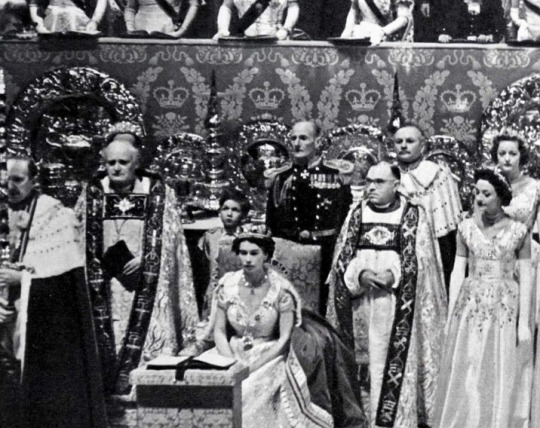
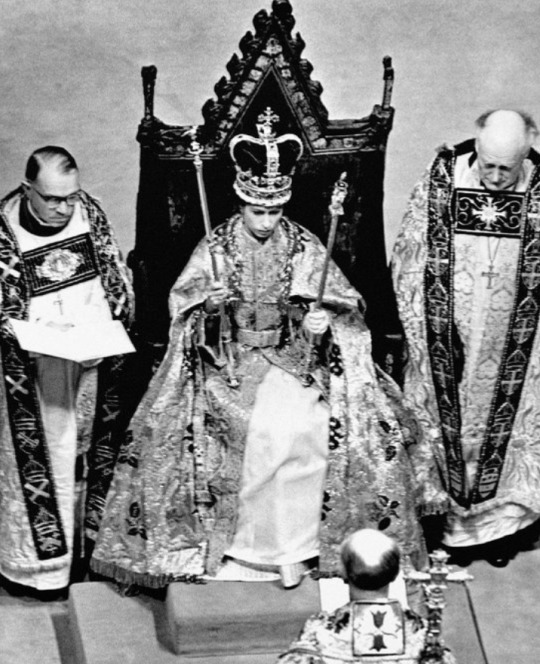

Beaton rushed to Buckingham Palace to photograph the Queen theatrically against a painted backdrop, holding the orb and sceptre and wearing the Imperial State Crown.
The Crown Jeweller Garrard remained until The Queen and the Duke of Edinburgh had taken lunch in the Abbey annex, in case any last-minute adjustments to the diamond-encrusted Crown were needed.
“Cecil was waiting when we all returned from the Abbey,” Lady Anne continues.
“He had everything set up for the photographs, and that’s when I really noticed the Crown and jewels glittering under the bright lights and took note of it all.
The Queen looked so young, beautiful and vulnerable, so the contrast of seeing her crowned with all the regalia was extraordinary.
She was weighted down a bit, but I remember thinking it was terribly poignant.”
A tense moment followed.
“The Duke of Edinburgh was fussing around, and Cecil got irritated, put his camera down and said, ‘Oh Sir, would you prefer to take the photographs?’” Lady Anne laughs.
“The Queen looked a bit horrified, and The Duke wandered off. You see, The Duke would have liked the photographer Baron, but it was The Queen Mother who adored Cecil.”

Later, it was still rainy and dark outside.
When the gleaming, crowned figure of The Queen appeared on the Buckingham Palace balcony, she shone with a sense of tradition and permanence.
With the Imperial State Crown, she wore the Coronation necklace and earrings, made in 1858 by Garrard and worn by Queen Alexandra and Queen Mary, including 25 brilliants suspending the Lahore diamond drop.
Time will tell if the Armills will return to being carried at the Coronation of HRH The Prince of Wales, and if he has inherited the Windsor head shape, but should substantial adjustments be required, the crown will appear once more unchanged.
The historical continuity of the regalia, and the fact the crown is still in constant use, makes these jewels created in the Garrard workshop the most potent in the world.
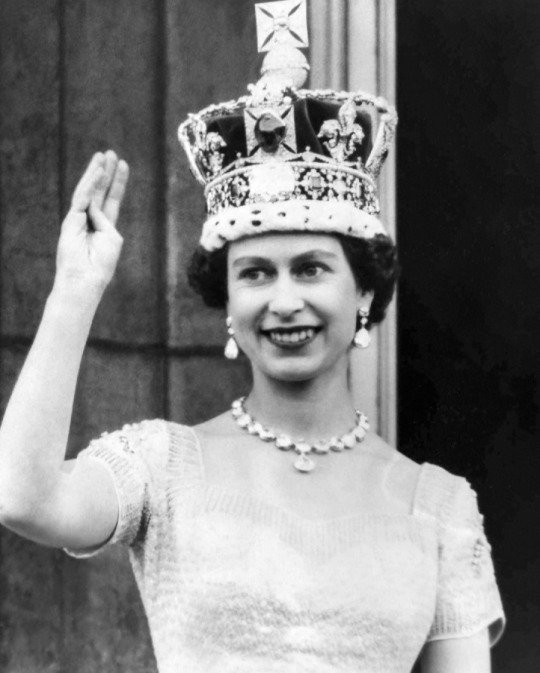
#Her Majesty Queen Elizabeth II’s Coronation#Coronation 1953#Queen Elizabeth II#Norman Hartnell#Duke of Norfolk#Cecil Beaton#Westminster Abbey#Garrard#King George VI#Queen Victoria#Cullinan II#Black Prince’s Ruby#Henry V#King Charles II#Prince Philip#Queen Elizabeth The Queen Mother#Buckingham Palace#British Royal Family#St Edward's Crown#Imperial State Crown#Jewel House#Tower of London
51 notes
·
View notes
Text
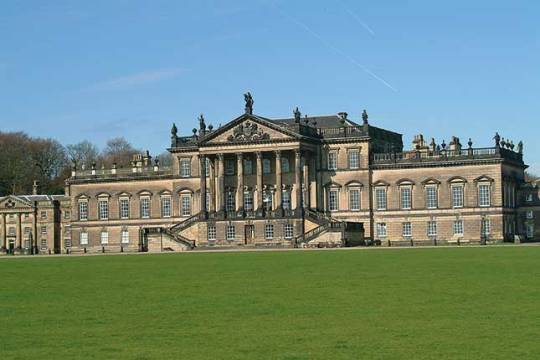


Wentworth Woodhouse, South Yorkshire
The largest private residence in Europe, Wentworth is twice the width of Buckingham Palace. This 18th-century mansion has recently been bought and will undergo £40m of restoration work over the next 20 years.
It was once the home of Charles I’s ill-fated administrator, Thomas Wentworth, 1st Earl of Strafford. Wentworth was tried and beheaded for treason in 1641. The house also hosted a visit by King George V and Queen Mary in 1912.
92 notes
·
View notes
Text
During Henry's reign there were six principal occasions of estate: his coronation in 1509, the meeting with Francis I at the Field of Cloth of Gold in 1520, the visit of Charles V in 1522, the meeting with Francis in Calais in 1532, Anne Boleyn's coronation in 1533 and the reception of Anne of Cleves in 1540. These were very much the exception; most occasions of estate were far less glamorous, such as the creation of peers, reception of ambassadors and the courtly ettiquette of births, deaths, and marriages.
The Royal Palaces of Tudor England, Simon Thurley
18 notes
·
View notes
Note
https://youtube.com/watch?v=Cu7p5-9wZ5Y&si=EnSIkaIECMiOmarE
Please watch this video and see how Roya wasn't confident about her exclusive when Piers Morgan told her that his impeccable palace source told him that there is absolutely no reconcilation talks on the table. Roya then said those close to Charles say he won't want to be enstranged from Harry for ever. But that's not what she wrote. Of course no parent want to be enstranged from his child forever.
But what she implied in her report was that reconcilation talks have started already and will happen by April. She could not defend her report when Piers confronted her. That's why I always side eye any report Roya does. 90 percent of the time, she's wrong.
She always also trying to hide her tracks, no way can she risk losing her line to Harry. In a world of cut throat reporting, a direct line inside is everything. It’s not like she could have admitted to Piers that Harry fed her that story.
49 notes
·
View notes
Text



After a Bible reading.
Joachim: His Majesty's death is a real tragedy. Like every Napoléon, Charles built the Francesim. A modern Francesim, which fights relentlessly against the baseness of which some humans are capable without remorse. Every day is a new conquest. This is the Empire of Francesim.



Joachim: My sovereign Napoléon, my dear friend Charles, has left us. In his own way, and in the Simparte way: with a heroic gesture that will forever mark history. We all mourn his passing. May he be an inspiration to us all. In his image, we must continue his struggles.


Joachim: With all our loyalty and devotion, we mourn the loss of His Majesty. May he rest in peace with the previous monarchs of Francesim. We support the Imperial family and our new Emperor.

⚜ State funeral of His Majesty Emperor Napoléon IV of Francesim ⚜
His Majesty's official funeral programme
I. Vigil in front of the Tuileries Palace in the square courtyard of the Louvre Palace
II. His late Imperial Majesty the Emperor Napoléon IV joins the cathedral of Notre-Dame de Paris
III. Monarchies of Europesim pay a first tribute to His Imperial Majesty, Emperor Napoléon IV
IV. Military parade given in honour of the Emperor Napoléon IV
V. State funeral of His Majesty Emperor Napoléon IV of Francesim : part 1, part 2, part 3, part 4, part 5
⚜ Collaborations : @trentonsimblr, @officalroyalsofpierreland, @funkyllama, @armoricaroyalty, @royalhouseoflaughlin, @royalhouseofcarrington, @houseoflennoxx, @trhor, @simswhitehouse, @whitmoreroyals, @nexility-sims
#simparte#gen 2#sim : louis#sim : marie joséphine#sim : hortense#sims 4#ts4#funeralnapoléoniv#sims 4 royal story#sims 4 royal#sims 4 royalty#invalides#paris#ts4 royal#ts4 royalty#ts4 royal simblr#ts4 royal family
44 notes
·
View notes
Photo
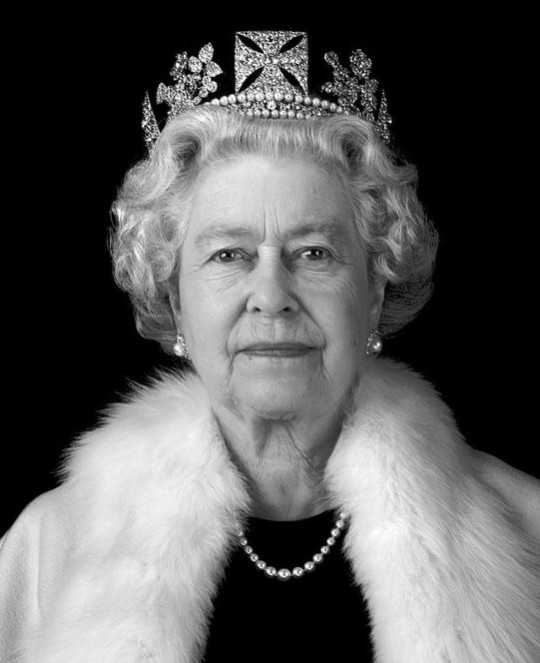
The long reign of Queen Elizabeth II was marked by her strong sense of duty and her determination to dedicate her life to her throne and to her people.
She became for many the one constant point in a rapidly changing world as British influence declined, society changed beyond recognition and the role of the monarchy itself came into question.
Her success in maintaining the monarchy through such turbulent times was even more remarkable given that, at the time of her birth, no-one could have foreseen that the throne would be her destiny.
Elizabeth Alexandra Mary Windsor was born on 21 April 1926, in a house just off Berkeley Square in London, the first child of Albert, Duke of York, second son of George V, and his duchess, the former Lady Elizabeth Bowes-Lyon.
Both Elizabeth and her sister, Margaret Rose, who was born in 1930, were educated at home and brought up in a loving family atmosphere. Elizabeth was extremely close to both her father and her grandfather, George V.
At the age of six, Elizabeth told her riding instructor that she wanted to become a "country lady with lots of horses and dogs".
She was said to have shown a remarkable sense of responsibility from a very early age. Winston Churchill, the future prime minister, was quoted as saying that she possessed "an air of authority that was astonishing in an infant".
Despite not attending school, Elizabeth proved adept at languages and made a detailed study of constitutional history.
A special Girl Guides company, the 1st Buckingham Palace, was formed so that she could socialise with girls of her own age.
Increasing tension
On the death of George V in 1936, his eldest son, known as David, became Edward VIII.
However, his choice of wife, the twice-divorced American Wallis Simpson, was deemed to be unacceptable on political and religious grounds. At the end of the year he abdicated.
A reluctant Duke of York became King George VI. His Coronation gave Elizabeth a foretaste of what lay in store for her and she later wrote that she had found the service "very, very wonderful".
Against a background of increasing tension in Europe, the new King, together with his wife, Queen Elizabeth, set out to restore public faith in the monarchy. Their example was not lost on their elder daughter.
In 1939, the 13-year-old princess accompanied the King and Queen to the Royal Naval College at Dartmouth.
Together with her sister Margaret, she was escorted by one of the cadets, her third cousin, Prince Philip of Greece.
Obstacles
It was not the first time they had met, but it was the first time she took an interest in him.
Prince Philip called on his royal relatives when on leave from the navy, and by 1944, when she was 18, Elizabeth was clearly in love with him. She kept his picture in her room and they exchanged letters.
The young princess briefly joined the Auxiliary Territorial Service (ATS) towards the end of the war, learning to drive and service a lorry. On VE Day, she joined the Royal Family at Buckingham Palace as thousands gathered in The Mall to celebrate the end of the war in Europe.
"We asked my parents if we could go out and see for ourselves," she later recalled. "I remember we were terrified of being recognised. I remember lines of unknown people linking arms and walking down Whitehall, all of us just swept along on a tide of happiness and relief."
After the war, her desire to marry Prince Philip faced a number of obstacles.
The King was reluctant to lose a daughter on whom he doted, and Philip had to overcome the prejudice of an establishment that could not accept his foreign ancestry.
But the wishes of the couple prevailed and on 20 November 1947 the couple married in Westminster Abbey.
The Duke of Edinburgh, as Philip had become, remained a serving naval officer. For a short time, a posting to Malta meant the young couple could enjoy a relatively normal life.
Their first child, Charles, was born in 1948, followed by a sister, Anne, who arrived in 1950.
But the King, having suffered considerable stress during the war years, was terminally ill with lung cancer, brought about by a lifetime of heavy smoking.
In January 1952, Elizabeth, then 25, set off with Philip for an overseas tour. The King, against medical advice, went to the airport to see the couple off. It was to be the last time Elizabeth would see her father.
Elizabeth heard of the death of the King while staying at a game lodge in Kenya and the new Queen immediately returned to London.
"In a way, I didn't have an apprenticeship," she later recalled. "My father died much too young, so it was all a very sudden kind of taking on and making the best job you can."
Personal attack
Her Coronation in June 1953 was televised, despite the opposition of Prime Minister Winston Churchill, and millions gathered around TV sets, many of them for the first time, to watch as Queen Elizabeth II made her oath.
With Britain still enduring post-war austerity, commentators saw the Coronation as the dawn of a new Elizabethan age.
World War Two had served to hasten the end of the British Empire, and by the time the new Queen set off on a lengthy tour of the Commonwealth in November 1953, many former British possessions, including India, had gained independence.
Elizabeth became the first reigning monarch to visit Australia and New Zealand. It was estimated that three-quarters of Australians turned out to see her in person.
Throughout the 1950s, more countries hauled down the union flag and the former colonies and dominions now came together as a voluntary family of nations.
Many politicians felt that the new Commonwealth could become a counter to the newly emerging European Economic Community and, to some extent, British policy turned away from the Continent.
But the decline of British influence was hastened by the Suez debacle in 1956, when it became clear that the Commonwealth lacked the collective will to act together in times of crisis. The decision to send British troops to try to prevent Egypt's threatened nationalisation of the Suez Canal ended in an ignominious withdrawal and brought about the resignation of Prime Minister Anthony Eden.
This embroiled the Queen in a political crisis. The Conservative Party had no mechanism for electing a new leader and, after a series of consultations, the Queen invited Harold Macmillan to form a new government.
The Queen also found herself the subject of a personal attack by the writer Lord Altrincham. In a magazine article, he claimed her court was "too British" and "upper-class" and accused her of being unable to make a simple speech without a written text.
His remarks caused a furore in the press and Lord Altrincham was physically attacked in the street by a member of the League of Empire Loyalists.
Nevertheless, the incident demonstrated that British society and attitudes to the monarchy were changing fast and old certainties were being questioned.
From 'the Monarchy' to 'the Royal Family'
Encouraged by her husband, notoriously impatient with the court's stuffiness, the Queen began to adapt to the new order.
The practice of receiving debutantes at court was abolished and the term "the Monarchy" was gradually replaced by "the Royal Family".
The Queen was once more at the centre of a political row when in 1963, Harold Macmillan stood down as prime minister. With the Conservative Party still to set up a system for choosing a new leader, she followed his advice to appoint the Earl of Home in his place.
It was a difficult time for the Queen. The hallmark of her reign was constitutional correctness, and a further separation of the monarchy from the government of the day. She took seriously her rights to be informed, to advise and to warn - but did not seek to step beyond them.
It was to be the last time she would be put in such a position. The Conservatives finally did away with the tradition that new party leaders just "emerged", and a proper system was put in place.
By the late 1960s, Buckingham Palace had decided that it needed to take a positive step to show the Royal Family in a far less formal and more approachable way.
The result was a ground-breaking documentary, Royal Family. The BBC was allowed to film the Windsors at home. There were pictures of the family at a barbecue, decorating the Christmas tree, taking their children for a drive - all ordinary activities, but never seen before.
Critics claimed that Richard Cawston's film destroyed the mystique of the royals by showing them to be ordinary people, including scenes of the Duke of Edinburgh barbecuing sausages in the grounds at Balmoral.
But the film echoed the more relaxed mood of the times and did much to restore public support for the monarchy.
By 1977, the Silver Jubilee was celebrated with genuine enthusiasm in street parties and in ceremonies across the kingdom. The monarchy seemed secure in the public's affection and much of that was down to the Queen herself.
Two years later, Britain had, in Margaret Thatcher, its first woman prime minister. Relations between the female head of state and female head of government were sometimes said to have been awkward.
Scandals and disasters
One difficult area was the Queen's devotion to the Commonwealth, of which she was head. The Queen knew the leaders of Africa well and was sympathetic to their cause.
She was reported to have found Thatcher's attitude and confrontational style "puzzling", not least over the prime minister's opposition to sanctions against apartheid South Africa.
Year by year, the Queen's public duties continued. After the Gulf War in 1991, she went to the United States to become the first British monarch to address a joint session of Congress. President George HW Bush said she had been "freedom's friend for as long as we can remember".
However, a year later, a series of scandals and disasters began to affect the Royal Family.
The Queen's second son, the Duke of York, and his wife Sarah separated, while Princess Anne's marriage to Mark Phillips ended in divorce. Then the Prince and Princess of Wales were revealed to be deeply unhappy and eventually split up.
The year culminated in a huge fire at the Queen's favourite residence, Windsor Castle. It seemed a grimly appropriate symbol of a royal house in trouble. It was not helped by a public row over whether the taxpayer, or the Queen, should foot the bill for the repairs.
The Queen described 1992 as her "annus horribilis" and, in a speech in the City of London, appeared to concede the need for a more open monarchy in return for a less hostile media.
"No institution, city, monarchy, whatever, should expect to be free from the scrutiny of those who give it their loyalty and support, not to mention those who don't. But we are all part of the same fabric of our national society and that scrutiny can be just as effective if it is made with a measure of gentleness, good humour and understanding."
The institution of monarchy was very much on the defensive. Buckingham Palace was opened to visitors to raise money to pay for the repairs at Windsor and it was announced that the Queen and the Prince of Wales would pay tax on investment income.
Abroad, the hopes for the Commonwealth, so high early in her reign, had not been fulfilled. Britain had turned its back on its old partners with new arrangements in Europe.
The Queen still saw value in the Commonwealth and was deeply gratified when South Africa, where she had come of age, at last threw apartheid aside. She celebrated with a visit in March 1995.
At home, the Queen sought to maintain the dignity of the monarchy while public debate continued on whether the institution had any future.
Death of Diana, Princess of Wales
As Britain struggled to find a new destiny, she tried to remain a reassuring figure, and with a sudden smile could lighten a solemn moment. The role she valued above all was that of symbol of the nation.
However, the monarchy was shaken and the Queen herself attracted unusual criticism after the death of Diana, Princess of Wales, in a car accident in Paris in August 1997.
As the public crowded around the palaces in London with tributes of flowers, the Queen seemed reluctant to provide the focus that she had always tried to do during great national moments.
Many of her critics failed to understand that she was from a generation that recoiled from the almost hysterical displays of public mourning that typified the aftermath of the princess's death.
She also felt as a caring grandmother that she needed to comfort Diana's sons in the privacy of the family circle.
Eventually, she made a live broadcast, paying tribute to her daughter-in-law and making a commitment that the monarchy would adapt.
Losses and celebrations
The deaths of the Queen Mother and Princess Margaret, in the Queen's Golden Jubilee year, 2002, cast a shadow over nationwide celebrations of her reign.
But despite this, and the recurring debate over the future of the monarchy, a million people crowded into The Mall, in front of Buckingham Palace, on the evening of the jubilee.
In April 2006, thousands of well-wishers lined the streets of Windsor as the Queen performed an informal walkabout on her 80th birthday.
And in November 2007, she and Prince Philip celebrated 60 years of marriage with a service attended by 2,000 people at Westminster Abbey.
There was yet another happy occasion in April 2011 when the Queen attended the wedding of her grandson, William, Duke of Cambridge, to Catherine Middleton.
In May that year she became the first British monarch to make an official visit to the Irish Republic, an event of great historical significance.
In a speech, which she began in Irish, she called for forbearance and conciliation and referred to "things we wish had been done differently or not at all".
Referendum
A year later, on a visit to Northern Ireland as part of the Diamond Jubilee celebrations, she shook hands with the former IRA commander Martin McGuinness.
It was a poignant moment for a monarch whose much-loved cousin, Lord Louis Mountbatten, had been killed by an IRA bomb in 1979.
The Diamond Jubilee brought hundreds of thousands of people on to the streets and culminated in a weekend of celebrations in London.
The referendum on Scottish independence, in September 2014, was a testing time for the Queen. Few had forgotten her speech to Parliament in 1977 in which she made clear her commitment to a United Kingdom.
"I number kings and queens of England and of Scotland, and princes of Wales among my ancestors and so I can readily understand these aspirations. But I cannot forget that I was crowned Queen of the United Kingdom of Great Britain and Northern Ireland."
In a remark to well-wishers at Balmoral on the eve of the Scottish referendum, which was overheard, she said she hoped people would think very carefully about the future.
Once the result of the vote was known, her public statement underlined the relief she felt that the Union was still intact, although recognising that the political landscape had changed.
"Now, as we move forward, we should remember that despite the range of views that have been expressed, we have in common an enduring love of Scotland, which is one of the things that helps to unite us all."
On 9 September 2015 she became the longest reigning monarch in British history, surpassing the reign of her great-great-grandmother Queen Victoria. In typical style she refused to make any fuss saying the title was "not one to which I have ever aspired".
Less than a year later, in April 2016, she celebrated her 90th birthday.
She continued with her public duties, often alone after the retirement of the Duke of Edinburgh in 2017.
There were continued strains on the family - including her husband's car accident, the Duke of York's ill-judged friendship with convicted American businessman Jeffrey Epstein and Prince Harry's growing disillusionment with life in the royal family.
These were unsettling moments, presided over by a monarch who demonstrated that she was still firmly in control. There was also the death of Prince Philip in April 2021, in the midst of the coronavirus pandemic, and her Platinum Jubilee a year later.
Although the monarchy might not have been as strong at the end of the Queen's reign as it was at the start, she was determined that it should continue to command a place of affection and respect in the hearts of the British people.
On the occasion of her Silver Jubilee, she recalled the pledge she had made on a visit to South Africa 30 years before.
"When I was 21, I pledged my life to the service of our people and I asked for God's help to make good that vow. Although that vow was made in my salad days, when I was green in judgement, I do not regret, or retract, one word of it."
Daily inspiration. Discover more photos at http://justforbooks.tumblr.com
100 notes
·
View notes